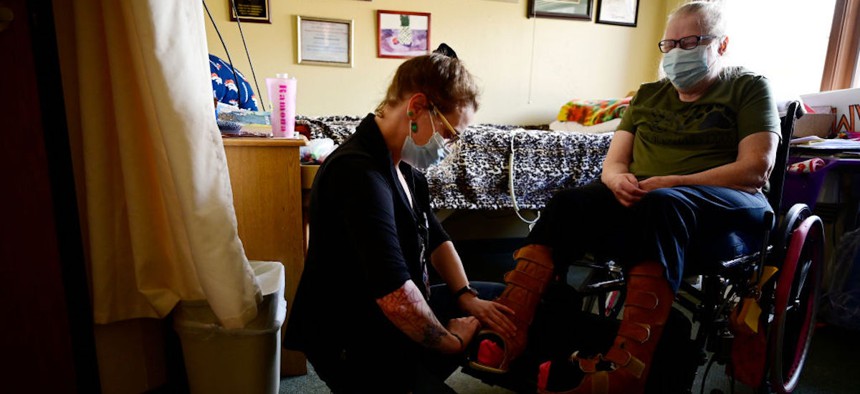States get some help to recruit caregivers for an aging population

Caregiver Dominique Wansaw helps Ramona Uppendahl wearing the leather feet covers at Good Samaritan Society nursing home in Loveland, Colorado, on Friday, March 4, 2022. Hyoung Chang/MediaNews Group/The Denver Post via Getty Images
With a projected 9.3 million direct care jobs needing to be filled by 2031, states must find ways to fill that gap. That’s why a new program is helping states build a direct care workforce.
The U.S. is facing an imbalance between the growing number of older adults needing increased care, and the diminishing availability of employees who can provide that care.
Aging individuals require various degrees of support, such as help with taking medications, preparing meals, bathing or maintaining social connections. That’s where direct care workers like nursing assistants, home health aides and personal care assistants step in. But low wages, poor working conditions and other factors are deterring people from entering the direct care workforce.
To meet the demand for direct care providers, states must undergo “a systems change,” said Josh Hodges, chief customer officer at the National Council on Aging, or NCOA, an advocacy group dedicated to improving care for older Americans.
States are recognizing that if they want to serve older adults, they “have to serve caregivers, and the direct care workforce is a vital part of the older adult experience,” he said. With a projected 9.3 million direct care jobs needing to be filled by 2031, states must find ways to fill that gap.
Bolstering the direct care workforce could help ensure older adults age in place and access the services they need to manage their health. It can also address high health care costs for patients and stakeholders, Hodges said. Home-based care providers, for instance, could reduce the need for older adults to enter nursing facilities under Medicaid.
To help improve the recruitment, training and retention of a direct care workforce, the NCOA’s Direct Care Workforce Strategies Center has launched a national technical assistance program for states and territories. Starting in April, selected states will receive virtual and onsite assistance to spur information sharing and best practices on how to address a shrinking direct care workforce.
States can apply to two programs under the initiative, but will be selected for one. The first is an intensive technical assistance program that looks to help officials determine the state-specific gaps in services and resources they could tap to better attract direct care workers.
Up to six multidisciplinary state teams will partner with a TA coach and subject matter expert to establish a plan for workforce recruitment, development and retention through reforms in policy, practice, programming, payment and performance, according to the federal Administration for Community Living, which is funding the program.
Participants will consider, for instance, establishing services to provide direct care workers housing, transportation and child care assistance. The program will also highlight ways states can attract workers like issuing educational credits or offering Medicaid benefits for direct care workers.
Officials could also brainstorm, for example, new policies for care coverage, worker compensation and reimbursement rates, Hodges said. Applicants must be cross-agency teams, including state agencies for Medicaid, workforce development, aging population services and other key stakeholders. Teams will be granted up to 250 hours of assistance for at least 12 months.
The second program supports peer-learning collaboratives in which selected states can collaborate and swap ideas for improving the direct care workforce. Under this portion of the program, participants will assess their states’ workforce needs and establish goals to bolster their direct care workforce. States will explore, for example, workforce development strategies such as establishing scholarship or apprenticeship programs to incentivize individuals to enter the direct care workforce. Officials will also investigate ways to improve the direct care system through technology, such as using data to inform budgetary and policy decisions.
The Strategies Center will host two to three peer-learning collaboratives of four to six states each, which will operate for up to six months and deliver at least one policy or program-related milestone. States will also receive 50 to 70 hours of technical assistance during the peer-learning collaborative.
Applications for both programs are due March 25. The Strategies Center will also host a webinar series starting March 7 so states can learn more about the center’s technical assistance opportunities. Individuals can register here.






